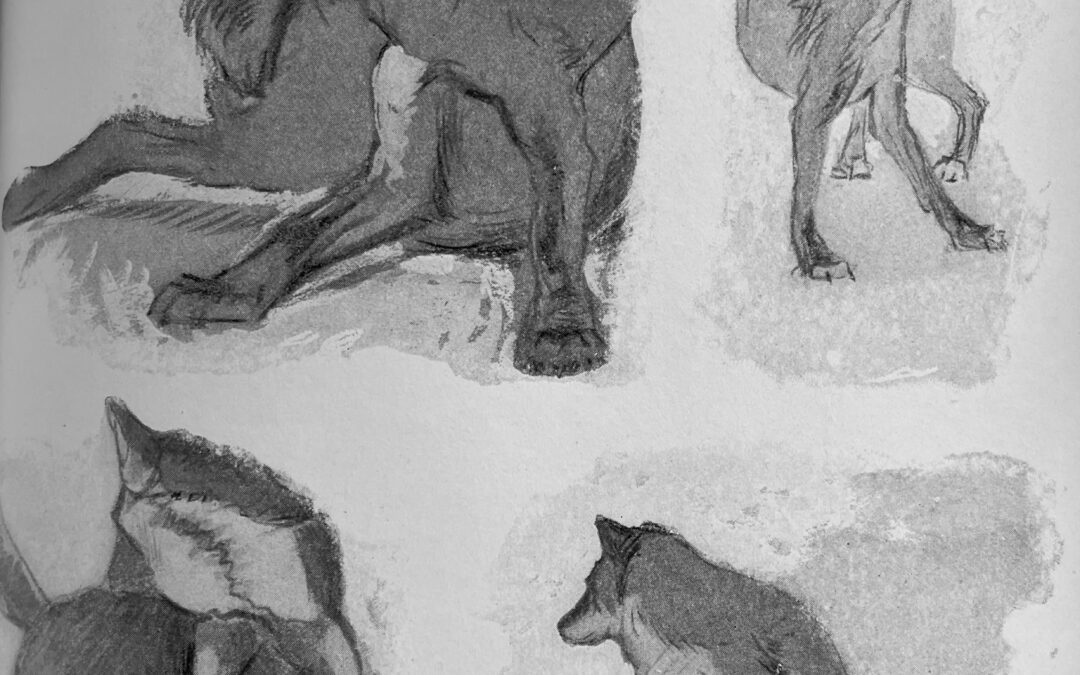Gray-Wolf Scratching Himself by Ernest Thompson Seton
This is one in an ongoing series of nature essays and artwork from Lives of Game Animals (1925-1928) by Ernest Thompson Seton. Seton’s analysis of Gray Wolf behavior was groundbreaking at the time. Since he devoted a large section of his Lives to Wolves, I am presenting his work over several blog postings. This time, the importance of sniffing.
HOW THEY SPREAD THE NEWS/Vol I Pg. 285-287
“Besides these sounds as a means of intercommunication, Wolves use example, already set forth, and scents. The scent method of communicating ideas I made the subject of an article in Forest & Stream, Jan. 23, 1897 (pp. 64-65). I reproduce the substance of it here.”
SMELL POWER
“It is well known that not only each species of animal, but that each individual has its own peculiar smell, conclusive evidence of which is found in the fact that a good Dog has no difficulty in following his master through a crowd, or keeping to the track of the animal he is hunting, though it be crossed by the tracks of many others.
It is further known that, even though it always retain its individuality, this personal odour varies with the condition of the animal. Thus a Horse smells strong after exercise; Canada grouse and Snowshoe Hares smell of spruce or cedar when they feed on these; a Mink smells different when angry; Dogs in ill-health become malodorous; Deer in rut become offensively strong-smelling; a female animal in rut is recognized afar by the scent.”
ODOUR-GLANDS
“In many species additional effect is given to the body-scent by the development of special glands which secrete a strong odour. These glands are usually situated in a part which is habitually brought in contact with the ground or the vegetation. Thus, in a Musk-deer they are on the side of the bell ; in the Peccary, on the back; in our common Deer, on the tarsus, between the toes, and in the lachrymal fossa. In some animals, however, the contact with the ground is secured in a different way. The glands are situated within the anal and preputial orifices, so that the natural excretions in transitu bear with them the taint which reveals so much to the next passer-by of the same species.
How much of these informational odours is supplied by the protometra is not yet known. The protometra or protometric gland is, according to Chauveau, a small pouch present in all domestic animals, and sometimes double, which secretes a fluid that is thrown into the urethra through a very small orifice near the Verumontanum.
George Fleming, the English editor, adds to this that the gland is not a gland in the ordinary sense of the term, but is certainly the rudiment of the duct that develops into the uterus of the female. It is also called the prostatic utricle or sinus pocularis.”
WOLF WIRELESS
“In order that the second animal may find the depot of intelligence quickly, it is necessary that his discovery of the place be not left to chance; and, incredible as it may seem at first sight, there is abundant proof that the whole of a region inhabited by Wolves is laid out in signal stations or intelligence depots. Usually there is one at each mile or less, varying much with the nature of the ground. The marks of these depots, or odour-posts, are various: a stone, a tree, a bush, a Buffalo skull, a post, a mound, or any similar object serves, provided only that it is conspicuous on account of its colour or position; usually it is more or less isolated, or else prominent by being at the crossing of two trails.
Now, a man returning to town goes at once to his hotel or club, glances over the last three or four names on the register, adds his own, then makes a more thorough inspection. And the behaviour of an animal arrived at an odour-post is precisely the same. It approaches, hastily sniffs the post, adds its own odour, then makes a more thorough investigation. The attention that Dogs pay to lamp-posts in town is precisely the same habit, a trifle overdeveloped through idleness, etc., but it will serve to illustrate. I have many times seen a Dog approach the post, sniff, then growl, register, growl again, and, with bristling mane and glowing eyes, scratch fiercely with his hind-feet, and walk off very stiffly, glancing back from time to time.
Again, it is common to see a Dog, after the preliminaries, become keenly interested. At other times one sees the animal, suddenly aroused by the news, take up a recent trail or fly to the next signal post, and so continue in pursuit of whatever it was that was sensed.”
REGISTERING
“Wolves do precisely the same, but I believe they carry it to a higher pitch, and there can be no doubt that a newly arrived Wolf is quickly aware of the visit that has recently been paid to the signal post-by a personal friend or foe, by a female in search of a mate, a young or old, sick or well, hungry, hunted, or gorged beast. From the trail he learns further the direction whence it came and whither it went. news essential to his life are obtained by the system of signal posts.”

